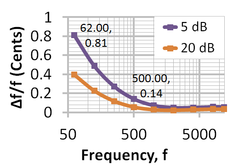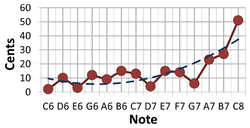Cent (music): Difference between revisions
imported>John R. Brews (→Sensitivity of the ear: See...also) |
mNo edit summary |
||
| Line 52: | Line 52: | ||
</ref> | </ref> | ||
}} | }}[[Category:Suggestion Bot Tag]] | ||
Latest revision as of 06:01, 26 July 2024
The cent is a logarithmic measure of a musical interval introduced by Alexander Ellis. A cent is the logarithmic division of the equitempered semitone into 100 equal parts.
Formula
In terms of a formula, the separation or interval between two frequencies ƒ1 and ƒ2 in cents is determined as:
Consequently, two frequencies ƒ1 and ƒ2 separated by an interval of 1 cent are in the ratio:
that is, by a ratio given by the 1200th root of 2.
Background
The cent appears in an article Alexander Ellis published in 1885[1] and also in an appendix he added to his translation of Herman von Helmholtz's Die Lehre von den Tonempfindungen published in translation as On the Sensation of Tone As a Physiological Basis for the Theory of Music,[2] and also as On the sensations of tone.[3]

Audible difference in frequency Δƒ/ƒ at two sound levels heard in rapid succession vs. frequency ƒ.[4]

Average error of nine flutists in playing a note of specified pitch after listening to a pitch A4 = 442 Hz from a piano.[5]
Sensitivity of the ear
- See also: Music perception
According to Ellis, when two notes are played together, a difference of 2 cents is noticeable, and a difference of 5 cents is heard as out of tune.[1]
The figure at right indicates a smaller sound level difference is audible when the sounds are louder, and smaller differences also are audible at higher frequencies.[4] The ability to distinguish pitches is extremely variable among listeners, increases with intensity, increases with the abruptness in change of tone, improves with the richness of timbre,[4] and varies with the shape of the envelope of the waveform that turns the tones on and off.[6]
Recent observations suggest errors of 5-15 cents when playing a specific pitch are common, with errors of 20-50 cents for pitches above A7 (the 7th octave, 3 octaves above the octave containing middle C). (See figure at right.) The increased error at higher pitch was traced to a systematic error in the response of auditory nerves in the ear.[5]
References
- ↑ 1.0 1.1 Alexander J Ellis (March 25, 1885). "On the musical scales of various nations; §III.–Cents". Journal of the Society of Arts 33: p. 487.
- ↑ Herman von Helmholtz (1912). “Footnote, p. 41 and Appendix XX, Section C”, On the Sensation of Tone As a Physiological Basis for the Theory of Music, Alexander Ellis translation of 4th 1877 German ed. Longmans, Green.
- ↑ Herman von Helmholtz (1954). On the sensations of tone, Reprint of 1885 translation by Alexander Ellis. Courier Dover Publications. ISBN 0486607534.
- ↑ 4.0 4.1 4.2 Carl Emil Seashore (1967). “Figure 1”, Psychology of Music, Reprint of McGraw-Hill 1938 ed. Courier Dover Publications, p. 60. ISBN 0-486-21851-1.
- ↑ 5.0 5.1 Ohgushi, K and Ano, Y (2005). "The Relationship between Musical Pitch and Temporal Responses of the Auditory Nerve Fibers". Journal of Physiological Anthropology and Applied Human Science 24 (1): pp. 99-101.
- ↑ William M. Hartmann (1997). Signals, Sound, and Sensation. Springer, p. 443. ISBN 1563962837.

